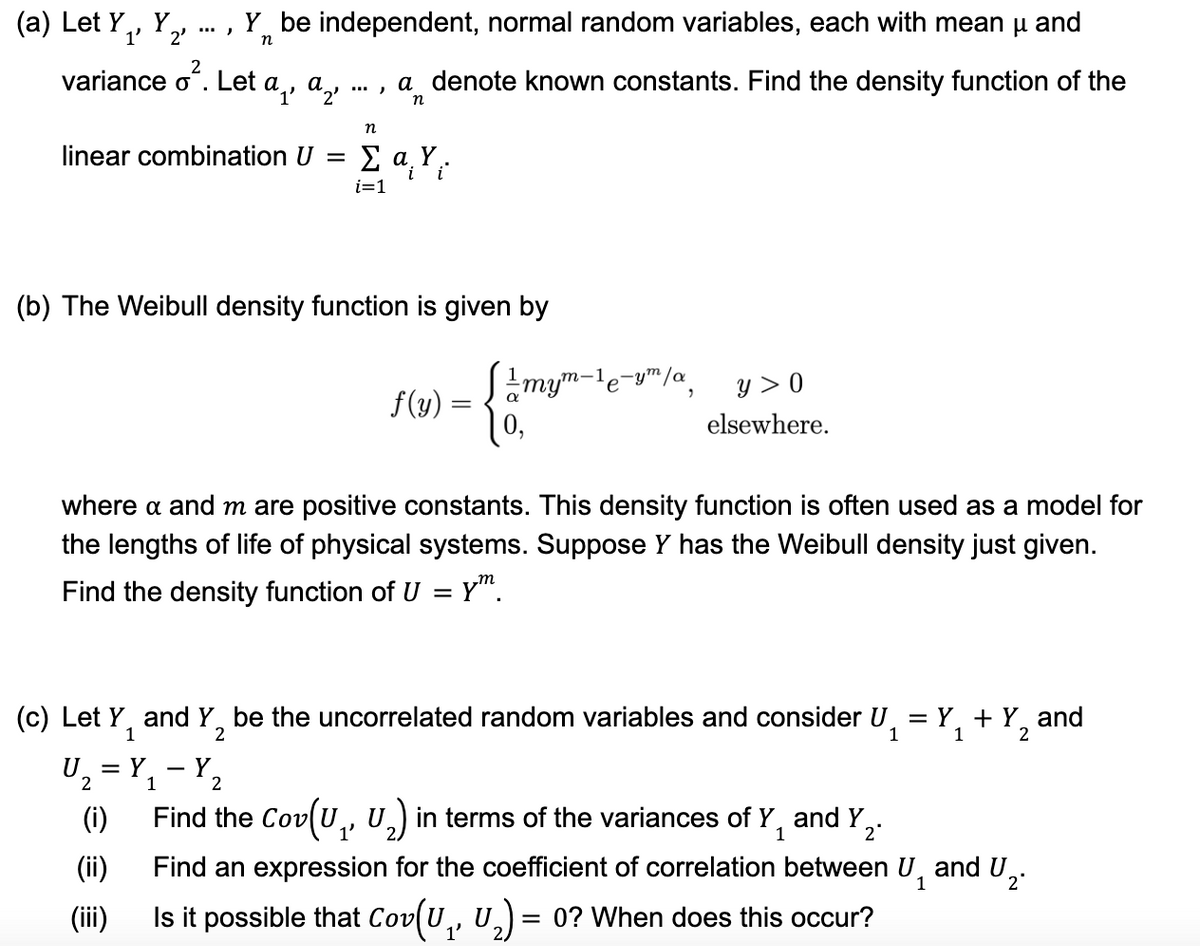(a) Let Y₁Y₂ 1' Y be independent, normal random variables, each with mean μ and n 2 variance o². Let a, a₂ linear combination U = a denote known constants. Find the density function of the ... " n n U₂ = Y₁ - Y₂ 2 1 (i) (ii) (iii) ΣαΥ. i=1 (b) The Weibull density function is given by {" f(y) = mym-le-ym/a, y>0 elsewhere. where a and m are positive constants. This density function is often used as a model for the lengths of life of physical systems. Suppose Y has the Weibull density just given. Find the density function of U = ym (c) Let Y₁ and Y₂ be the uncorrelated random variables and consider U₁ = Y₁ + Y₂ Y and 1 2 1 Find the Cov(U₁, U₂) in terms of the variances of Y₁ and Y₂2. 1 Find an expression for the coefficient of correlation between U₁ and U Is it possible that Cov(U₁, U₂) = 0? When does this occur? 2
(a) Let Y₁Y₂ 1' Y be independent, normal random variables, each with mean μ and n 2 variance o². Let a, a₂ linear combination U = a denote known constants. Find the density function of the ... " n n U₂ = Y₁ - Y₂ 2 1 (i) (ii) (iii) ΣαΥ. i=1 (b) The Weibull density function is given by {" f(y) = mym-le-ym/a, y>0 elsewhere. where a and m are positive constants. This density function is often used as a model for the lengths of life of physical systems. Suppose Y has the Weibull density just given. Find the density function of U = ym (c) Let Y₁ and Y₂ be the uncorrelated random variables and consider U₁ = Y₁ + Y₂ Y and 1 2 1 Find the Cov(U₁, U₂) in terms of the variances of Y₁ and Y₂2. 1 Find an expression for the coefficient of correlation between U₁ and U Is it possible that Cov(U₁, U₂) = 0? When does this occur? 2
A First Course in Probability (10th Edition)
10th Edition
ISBN:9780134753119
Author:Sheldon Ross
Publisher:Sheldon Ross
Chapter1: Combinatorial Analysis
Section: Chapter Questions
Problem 1.1P: a. How many different 7-place license plates are possible if the first 2 places are for letters and...
Related questions
Question

Transcribed Image Text:(a) Let Y₁, Y
1' 2'
2
variance oʻ. Let a¸, ª½
'1'
linear combination U =
Y be independent, normal random variables, each with mean μ and
n
U₂³
(i)
(ii)
(iii)
..., a denote known constants. Find the density function of the
n
(b) The Weibull density function is given by
= Y
1
n
Y
2
ΣαΥ;
i=1
f(y) =
where a and m are positive constants. This density function is often used as a model for
the lengths of life of physical systems. Suppose Y has the Weibull density just given.
Find the density function of U = y™.
1mym-¹e-ym/a,
е
(c) Let Y₁ and Y₂ be the uncorrelated random variables and consider U₁ = Y₁ + Y and
1
1
y > 0
elsewhere.
Find the Cov(U₁, U₂) in terms of the variances of Y and Y₂
1'
1
2*
Find an expression for the coefficient of correlation between U₁ and U₂
1
2*
Is it possible that Cov(U₁, U₂) = 0? When does this occur?
Expert Solution
This question has been solved!
Explore an expertly crafted, step-by-step solution for a thorough understanding of key concepts.
This is a popular solution!
Trending now
This is a popular solution!
Step by step
Solved in 2 steps with 2 images

Recommended textbooks for you

A First Course in Probability (10th Edition)
Probability
ISBN:
9780134753119
Author:
Sheldon Ross
Publisher:
PEARSON


A First Course in Probability (10th Edition)
Probability
ISBN:
9780134753119
Author:
Sheldon Ross
Publisher:
PEARSON
